Marketing Essentials: Analyzing Marketing Functions, Mix, and Strategy
VerifiedAdded on 2022/12/28
|40
|6005
|52
Report
AI Summary
This report delves into the core concepts of marketing, examining the roles and responsibilities of marketing functions within an organization and their interrelationships with other departments. It explores the impact of micro and macro environmental factors on marketing strategies. The report then focuses on the 7Ps of the marketing mix, analyzing how UNICEF, a non-profit organization, utilizes social media marketing to achieve its goals. It contrasts this with an analysis of Coca-Cola's marketing strategy, evaluating its alignment with organizational objectives. The report concludes that effective marketing functions, including research, strategy, planning, and tactics, along with strong interdepartmental cooperation, are crucial for organizational success. It highlights the importance of adapting marketing strategies to specific organizational contexts, particularly for non-profit entities like UNICEF. The report also reviews market environments and their influence, emphasizing the need for adaptability and strategic alignment.
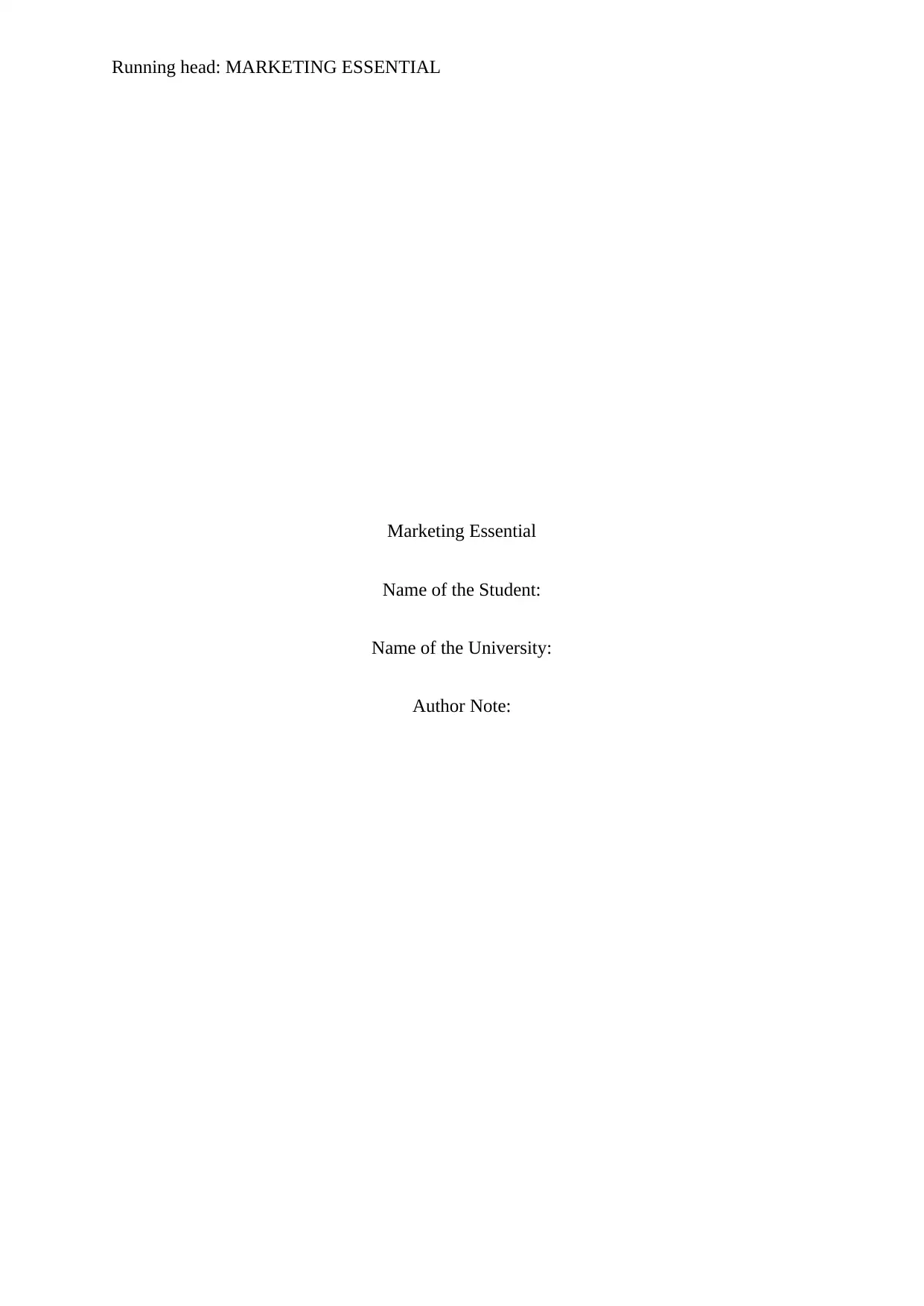
Running head: MARKETING ESSENTIAL
Marketing Essential
Name of the Student:
Name of the University:
Author Note:
Marketing Essential
Name of the Student:
Name of the University:
Author Note:
Paraphrase This Document
Need a fresh take? Get an instant paraphrase of this document with our AI Paraphraser
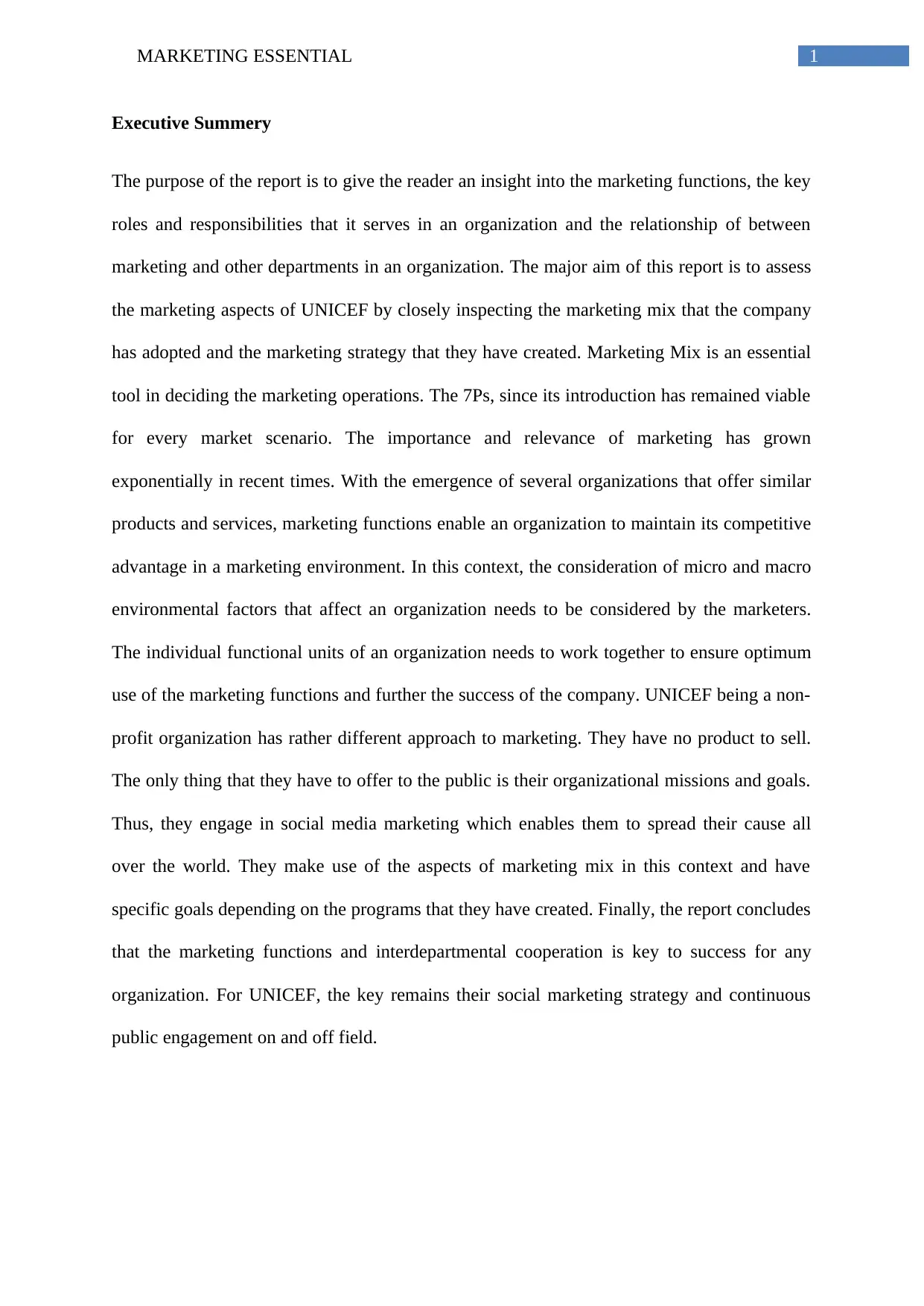
1MARKETING ESSENTIAL
Executive Summery
The purpose of the report is to give the reader an insight into the marketing functions, the key
roles and responsibilities that it serves in an organization and the relationship of between
marketing and other departments in an organization. The major aim of this report is to assess
the marketing aspects of UNICEF by closely inspecting the marketing mix that the company
has adopted and the marketing strategy that they have created. Marketing Mix is an essential
tool in deciding the marketing operations. The 7Ps, since its introduction has remained viable
for every market scenario. The importance and relevance of marketing has grown
exponentially in recent times. With the emergence of several organizations that offer similar
products and services, marketing functions enable an organization to maintain its competitive
advantage in a marketing environment. In this context, the consideration of micro and macro
environmental factors that affect an organization needs to be considered by the marketers.
The individual functional units of an organization needs to work together to ensure optimum
use of the marketing functions and further the success of the company. UNICEF being a non-
profit organization has rather different approach to marketing. They have no product to sell.
The only thing that they have to offer to the public is their organizational missions and goals.
Thus, they engage in social media marketing which enables them to spread their cause all
over the world. They make use of the aspects of marketing mix in this context and have
specific goals depending on the programs that they have created. Finally, the report concludes
that the marketing functions and interdepartmental cooperation is key to success for any
organization. For UNICEF, the key remains their social marketing strategy and continuous
public engagement on and off field.
Executive Summery
The purpose of the report is to give the reader an insight into the marketing functions, the key
roles and responsibilities that it serves in an organization and the relationship of between
marketing and other departments in an organization. The major aim of this report is to assess
the marketing aspects of UNICEF by closely inspecting the marketing mix that the company
has adopted and the marketing strategy that they have created. Marketing Mix is an essential
tool in deciding the marketing operations. The 7Ps, since its introduction has remained viable
for every market scenario. The importance and relevance of marketing has grown
exponentially in recent times. With the emergence of several organizations that offer similar
products and services, marketing functions enable an organization to maintain its competitive
advantage in a marketing environment. In this context, the consideration of micro and macro
environmental factors that affect an organization needs to be considered by the marketers.
The individual functional units of an organization needs to work together to ensure optimum
use of the marketing functions and further the success of the company. UNICEF being a non-
profit organization has rather different approach to marketing. They have no product to sell.
The only thing that they have to offer to the public is their organizational missions and goals.
Thus, they engage in social media marketing which enables them to spread their cause all
over the world. They make use of the aspects of marketing mix in this context and have
specific goals depending on the programs that they have created. Finally, the report concludes
that the marketing functions and interdepartmental cooperation is key to success for any
organization. For UNICEF, the key remains their social marketing strategy and continuous
public engagement on and off field.
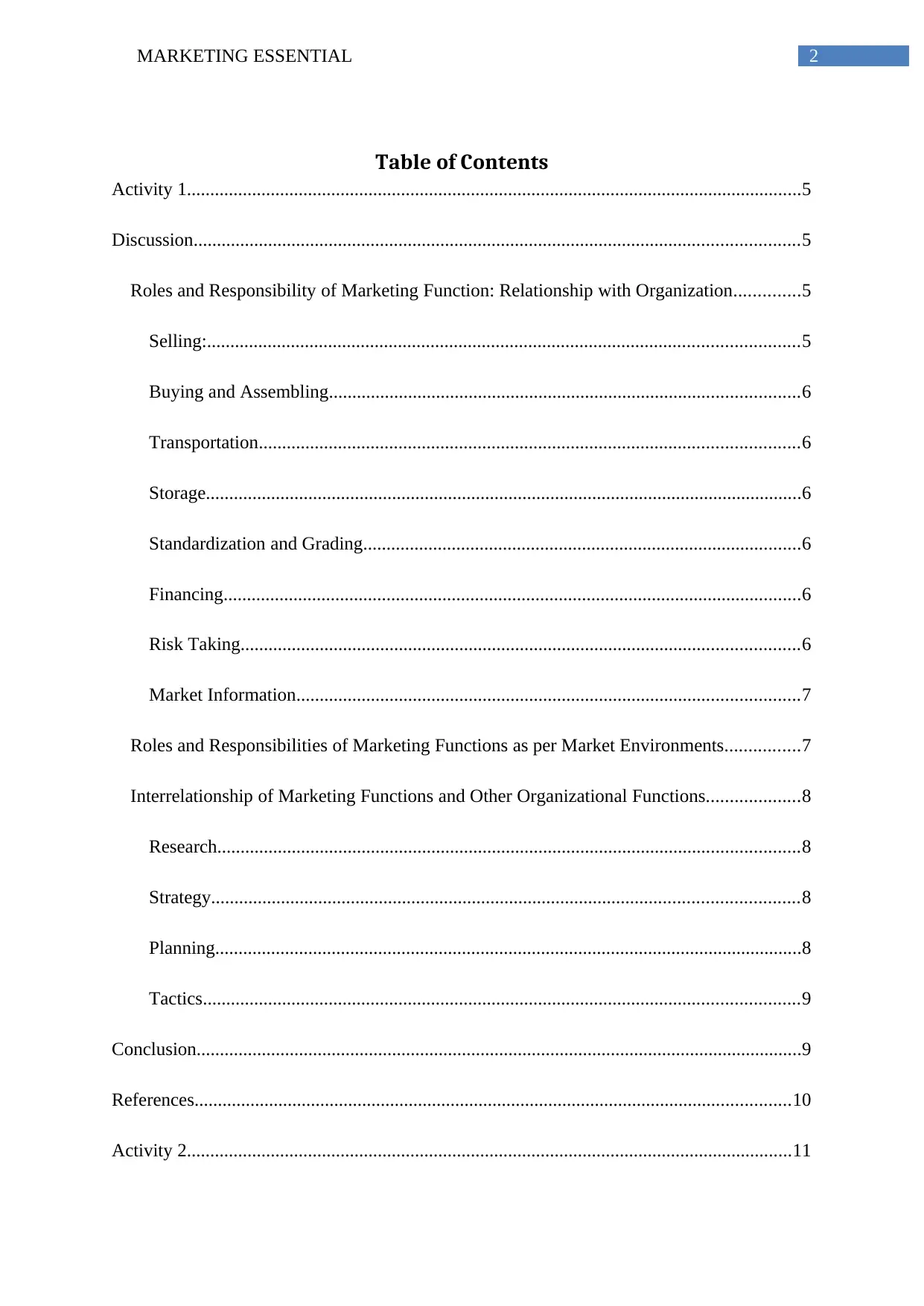
2MARKETING ESSENTIAL
Table of Contents
Activity 1....................................................................................................................................5
Discussion..................................................................................................................................5
Roles and Responsibility of Marketing Function: Relationship with Organization..............5
Selling:...............................................................................................................................5
Buying and Assembling.....................................................................................................6
Transportation....................................................................................................................6
Storage................................................................................................................................6
Standardization and Grading..............................................................................................6
Financing............................................................................................................................6
Risk Taking........................................................................................................................6
Market Information............................................................................................................7
Roles and Responsibilities of Marketing Functions as per Market Environments................7
Interrelationship of Marketing Functions and Other Organizational Functions....................8
Research.............................................................................................................................8
Strategy..............................................................................................................................8
Planning..............................................................................................................................8
Tactics................................................................................................................................9
Conclusion..................................................................................................................................9
References................................................................................................................................10
Activity 2..................................................................................................................................11
Table of Contents
Activity 1....................................................................................................................................5
Discussion..................................................................................................................................5
Roles and Responsibility of Marketing Function: Relationship with Organization..............5
Selling:...............................................................................................................................5
Buying and Assembling.....................................................................................................6
Transportation....................................................................................................................6
Storage................................................................................................................................6
Standardization and Grading..............................................................................................6
Financing............................................................................................................................6
Risk Taking........................................................................................................................6
Market Information............................................................................................................7
Roles and Responsibilities of Marketing Functions as per Market Environments................7
Interrelationship of Marketing Functions and Other Organizational Functions....................8
Research.............................................................................................................................8
Strategy..............................................................................................................................8
Planning..............................................................................................................................8
Tactics................................................................................................................................9
Conclusion..................................................................................................................................9
References................................................................................................................................10
Activity 2..................................................................................................................................11
⊘ This is a preview!⊘
Do you want full access?
Subscribe today to unlock all pages.

Trusted by 1+ million students worldwide
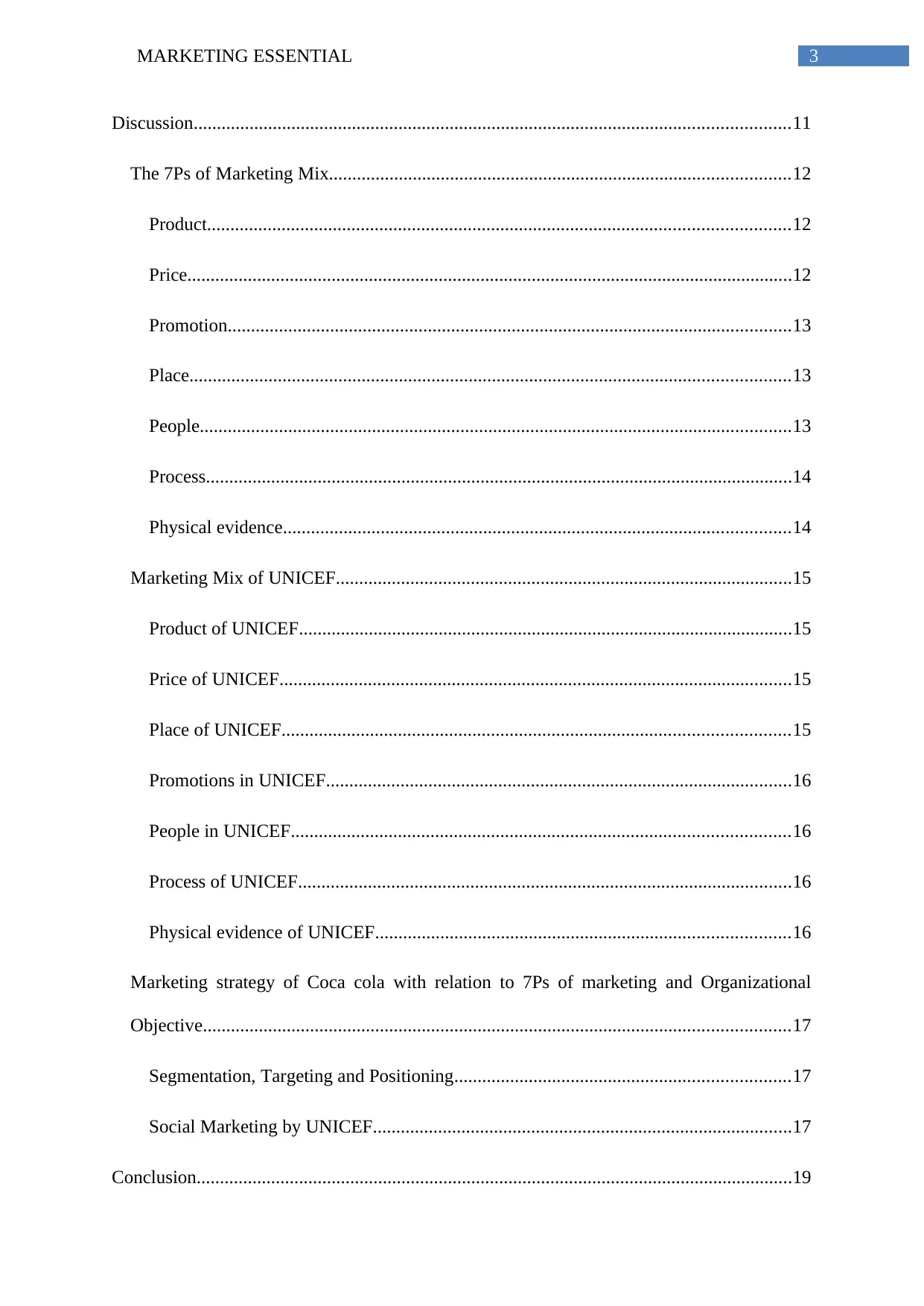
3MARKETING ESSENTIAL
Discussion................................................................................................................................11
The 7Ps of Marketing Mix...................................................................................................12
Product.............................................................................................................................12
Price..................................................................................................................................12
Promotion.........................................................................................................................13
Place.................................................................................................................................13
People...............................................................................................................................13
Process..............................................................................................................................14
Physical evidence.............................................................................................................14
Marketing Mix of UNICEF..................................................................................................15
Product of UNICEF..........................................................................................................15
Price of UNICEF..............................................................................................................15
Place of UNICEF.............................................................................................................15
Promotions in UNICEF....................................................................................................16
People in UNICEF...........................................................................................................16
Process of UNICEF..........................................................................................................16
Physical evidence of UNICEF.........................................................................................16
Marketing strategy of Coca cola with relation to 7Ps of marketing and Organizational
Objective..............................................................................................................................17
Segmentation, Targeting and Positioning........................................................................17
Social Marketing by UNICEF..........................................................................................17
Conclusion................................................................................................................................19
Discussion................................................................................................................................11
The 7Ps of Marketing Mix...................................................................................................12
Product.............................................................................................................................12
Price..................................................................................................................................12
Promotion.........................................................................................................................13
Place.................................................................................................................................13
People...............................................................................................................................13
Process..............................................................................................................................14
Physical evidence.............................................................................................................14
Marketing Mix of UNICEF..................................................................................................15
Product of UNICEF..........................................................................................................15
Price of UNICEF..............................................................................................................15
Place of UNICEF.............................................................................................................15
Promotions in UNICEF....................................................................................................16
People in UNICEF...........................................................................................................16
Process of UNICEF..........................................................................................................16
Physical evidence of UNICEF.........................................................................................16
Marketing strategy of Coca cola with relation to 7Ps of marketing and Organizational
Objective..............................................................................................................................17
Segmentation, Targeting and Positioning........................................................................17
Social Marketing by UNICEF..........................................................................................17
Conclusion................................................................................................................................19
Paraphrase This Document
Need a fresh take? Get an instant paraphrase of this document with our AI Paraphraser

4MARKETING ESSENTIAL
References................................................................................................................................20
References................................................................................................................................20
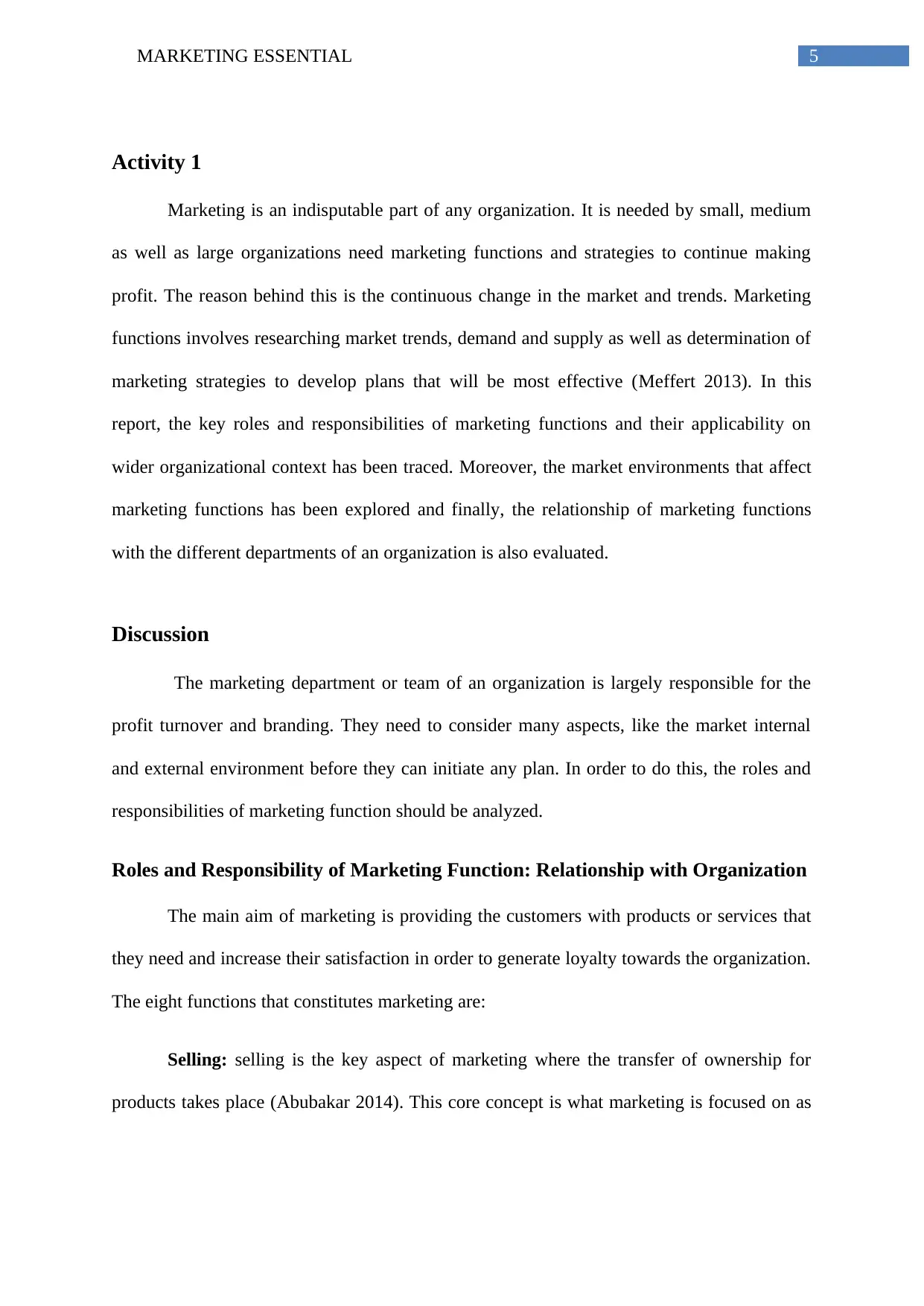
5MARKETING ESSENTIAL
Activity 1
Marketing is an indisputable part of any organization. It is needed by small, medium
as well as large organizations need marketing functions and strategies to continue making
profit. The reason behind this is the continuous change in the market and trends. Marketing
functions involves researching market trends, demand and supply as well as determination of
marketing strategies to develop plans that will be most effective (Meffert 2013). In this
report, the key roles and responsibilities of marketing functions and their applicability on
wider organizational context has been traced. Moreover, the market environments that affect
marketing functions has been explored and finally, the relationship of marketing functions
with the different departments of an organization is also evaluated.
Discussion
The marketing department or team of an organization is largely responsible for the
profit turnover and branding. They need to consider many aspects, like the market internal
and external environment before they can initiate any plan. In order to do this, the roles and
responsibilities of marketing function should be analyzed.
Roles and Responsibility of Marketing Function: Relationship with Organization
The main aim of marketing is providing the customers with products or services that
they need and increase their satisfaction in order to generate loyalty towards the organization.
The eight functions that constitutes marketing are:
Selling: selling is the key aspect of marketing where the transfer of ownership for
products takes place (Abubakar 2014). This core concept is what marketing is focused on as
Activity 1
Marketing is an indisputable part of any organization. It is needed by small, medium
as well as large organizations need marketing functions and strategies to continue making
profit. The reason behind this is the continuous change in the market and trends. Marketing
functions involves researching market trends, demand and supply as well as determination of
marketing strategies to develop plans that will be most effective (Meffert 2013). In this
report, the key roles and responsibilities of marketing functions and their applicability on
wider organizational context has been traced. Moreover, the market environments that affect
marketing functions has been explored and finally, the relationship of marketing functions
with the different departments of an organization is also evaluated.
Discussion
The marketing department or team of an organization is largely responsible for the
profit turnover and branding. They need to consider many aspects, like the market internal
and external environment before they can initiate any plan. In order to do this, the roles and
responsibilities of marketing function should be analyzed.
Roles and Responsibility of Marketing Function: Relationship with Organization
The main aim of marketing is providing the customers with products or services that
they need and increase their satisfaction in order to generate loyalty towards the organization.
The eight functions that constitutes marketing are:
Selling: selling is the key aspect of marketing where the transfer of ownership for
products takes place (Abubakar 2014). This core concept is what marketing is focused on as
⊘ This is a preview!⊘
Do you want full access?
Subscribe today to unlock all pages.

Trusted by 1+ million students worldwide
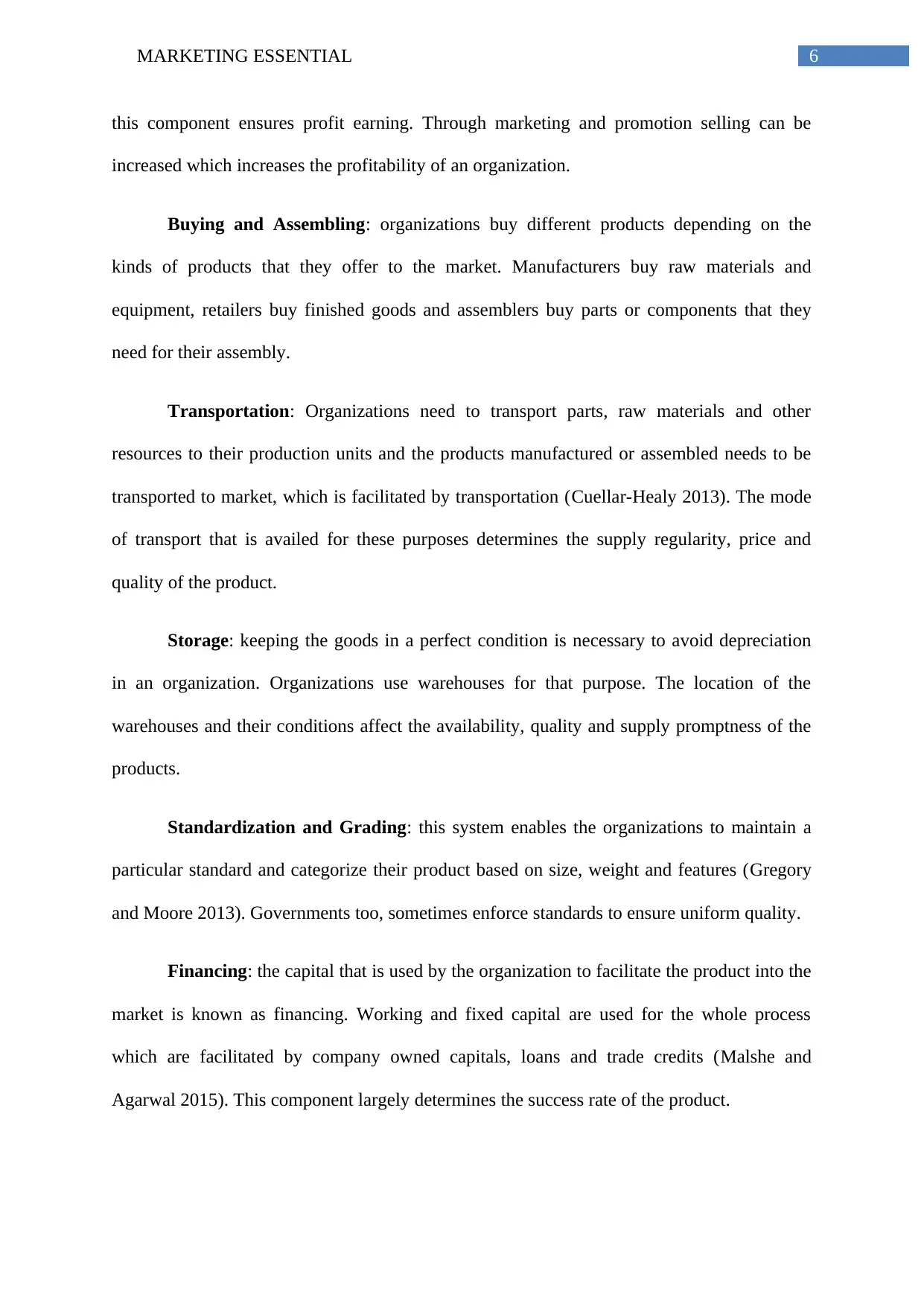
6MARKETING ESSENTIAL
this component ensures profit earning. Through marketing and promotion selling can be
increased which increases the profitability of an organization.
Buying and Assembling: organizations buy different products depending on the
kinds of products that they offer to the market. Manufacturers buy raw materials and
equipment, retailers buy finished goods and assemblers buy parts or components that they
need for their assembly.
Transportation: Organizations need to transport parts, raw materials and other
resources to their production units and the products manufactured or assembled needs to be
transported to market, which is facilitated by transportation (Cuellar-Healy 2013). The mode
of transport that is availed for these purposes determines the supply regularity, price and
quality of the product.
Storage: keeping the goods in a perfect condition is necessary to avoid depreciation
in an organization. Organizations use warehouses for that purpose. The location of the
warehouses and their conditions affect the availability, quality and supply promptness of the
products.
Standardization and Grading: this system enables the organizations to maintain a
particular standard and categorize their product based on size, weight and features (Gregory
and Moore 2013). Governments too, sometimes enforce standards to ensure uniform quality.
Financing: the capital that is used by the organization to facilitate the product into the
market is known as financing. Working and fixed capital are used for the whole process
which are facilitated by company owned capitals, loans and trade credits (Malshe and
Agarwal 2015). This component largely determines the success rate of the product.
this component ensures profit earning. Through marketing and promotion selling can be
increased which increases the profitability of an organization.
Buying and Assembling: organizations buy different products depending on the
kinds of products that they offer to the market. Manufacturers buy raw materials and
equipment, retailers buy finished goods and assemblers buy parts or components that they
need for their assembly.
Transportation: Organizations need to transport parts, raw materials and other
resources to their production units and the products manufactured or assembled needs to be
transported to market, which is facilitated by transportation (Cuellar-Healy 2013). The mode
of transport that is availed for these purposes determines the supply regularity, price and
quality of the product.
Storage: keeping the goods in a perfect condition is necessary to avoid depreciation
in an organization. Organizations use warehouses for that purpose. The location of the
warehouses and their conditions affect the availability, quality and supply promptness of the
products.
Standardization and Grading: this system enables the organizations to maintain a
particular standard and categorize their product based on size, weight and features (Gregory
and Moore 2013). Governments too, sometimes enforce standards to ensure uniform quality.
Financing: the capital that is used by the organization to facilitate the product into the
market is known as financing. Working and fixed capital are used for the whole process
which are facilitated by company owned capitals, loans and trade credits (Malshe and
Agarwal 2015). This component largely determines the success rate of the product.
Paraphrase This Document
Need a fresh take? Get an instant paraphrase of this document with our AI Paraphraser
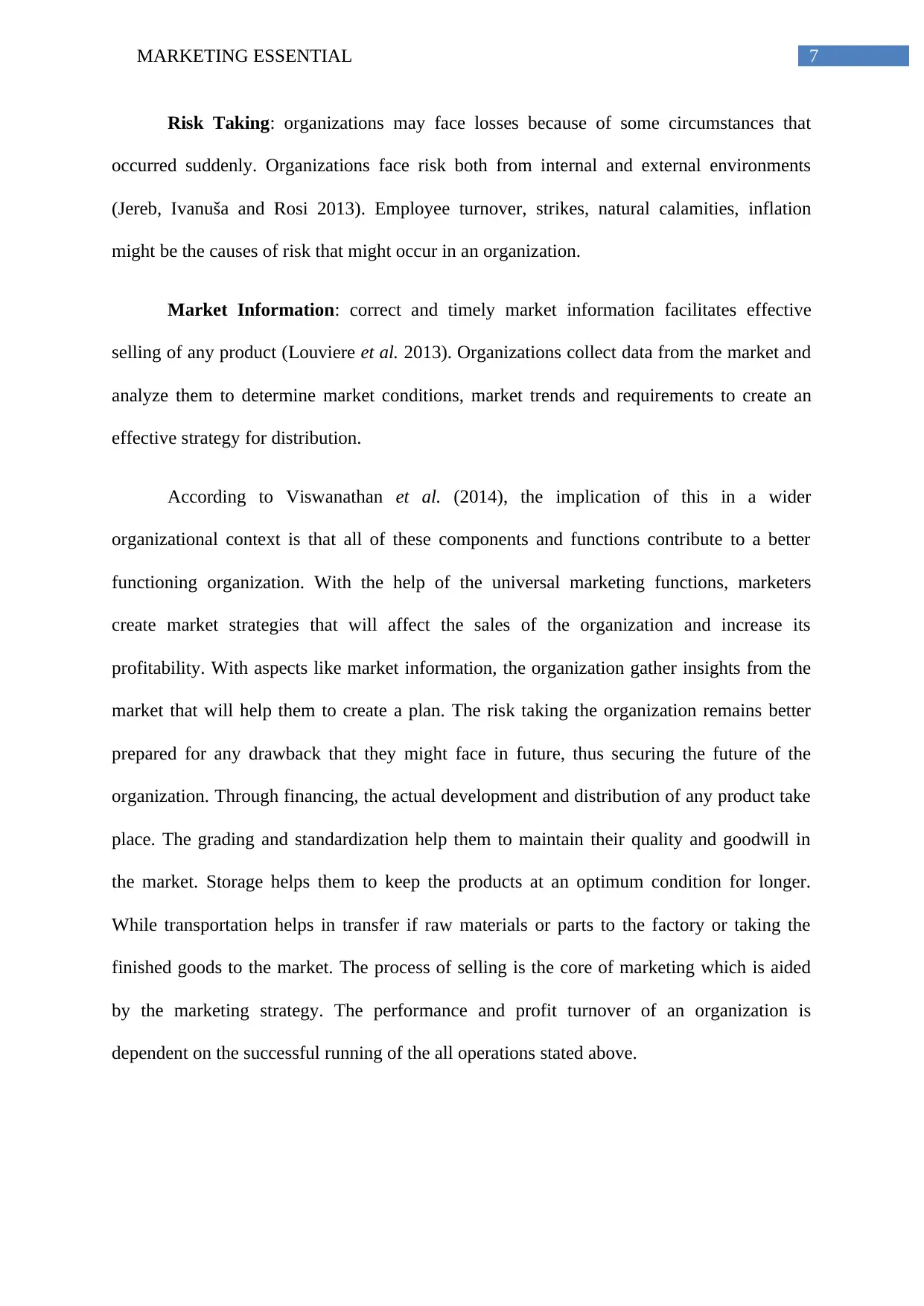
7MARKETING ESSENTIAL
Risk Taking: organizations may face losses because of some circumstances that
occurred suddenly. Organizations face risk both from internal and external environments
(Jereb, Ivanuša and Rosi 2013). Employee turnover, strikes, natural calamities, inflation
might be the causes of risk that might occur in an organization.
Market Information: correct and timely market information facilitates effective
selling of any product (Louviere et al. 2013). Organizations collect data from the market and
analyze them to determine market conditions, market trends and requirements to create an
effective strategy for distribution.
According to Viswanathan et al. (2014), the implication of this in a wider
organizational context is that all of these components and functions contribute to a better
functioning organization. With the help of the universal marketing functions, marketers
create market strategies that will affect the sales of the organization and increase its
profitability. With aspects like market information, the organization gather insights from the
market that will help them to create a plan. The risk taking the organization remains better
prepared for any drawback that they might face in future, thus securing the future of the
organization. Through financing, the actual development and distribution of any product take
place. The grading and standardization help them to maintain their quality and goodwill in
the market. Storage helps them to keep the products at an optimum condition for longer.
While transportation helps in transfer if raw materials or parts to the factory or taking the
finished goods to the market. The process of selling is the core of marketing which is aided
by the marketing strategy. The performance and profit turnover of an organization is
dependent on the successful running of the all operations stated above.
Risk Taking: organizations may face losses because of some circumstances that
occurred suddenly. Organizations face risk both from internal and external environments
(Jereb, Ivanuša and Rosi 2013). Employee turnover, strikes, natural calamities, inflation
might be the causes of risk that might occur in an organization.
Market Information: correct and timely market information facilitates effective
selling of any product (Louviere et al. 2013). Organizations collect data from the market and
analyze them to determine market conditions, market trends and requirements to create an
effective strategy for distribution.
According to Viswanathan et al. (2014), the implication of this in a wider
organizational context is that all of these components and functions contribute to a better
functioning organization. With the help of the universal marketing functions, marketers
create market strategies that will affect the sales of the organization and increase its
profitability. With aspects like market information, the organization gather insights from the
market that will help them to create a plan. The risk taking the organization remains better
prepared for any drawback that they might face in future, thus securing the future of the
organization. Through financing, the actual development and distribution of any product take
place. The grading and standardization help them to maintain their quality and goodwill in
the market. Storage helps them to keep the products at an optimum condition for longer.
While transportation helps in transfer if raw materials or parts to the factory or taking the
finished goods to the market. The process of selling is the core of marketing which is aided
by the marketing strategy. The performance and profit turnover of an organization is
dependent on the successful running of the all operations stated above.
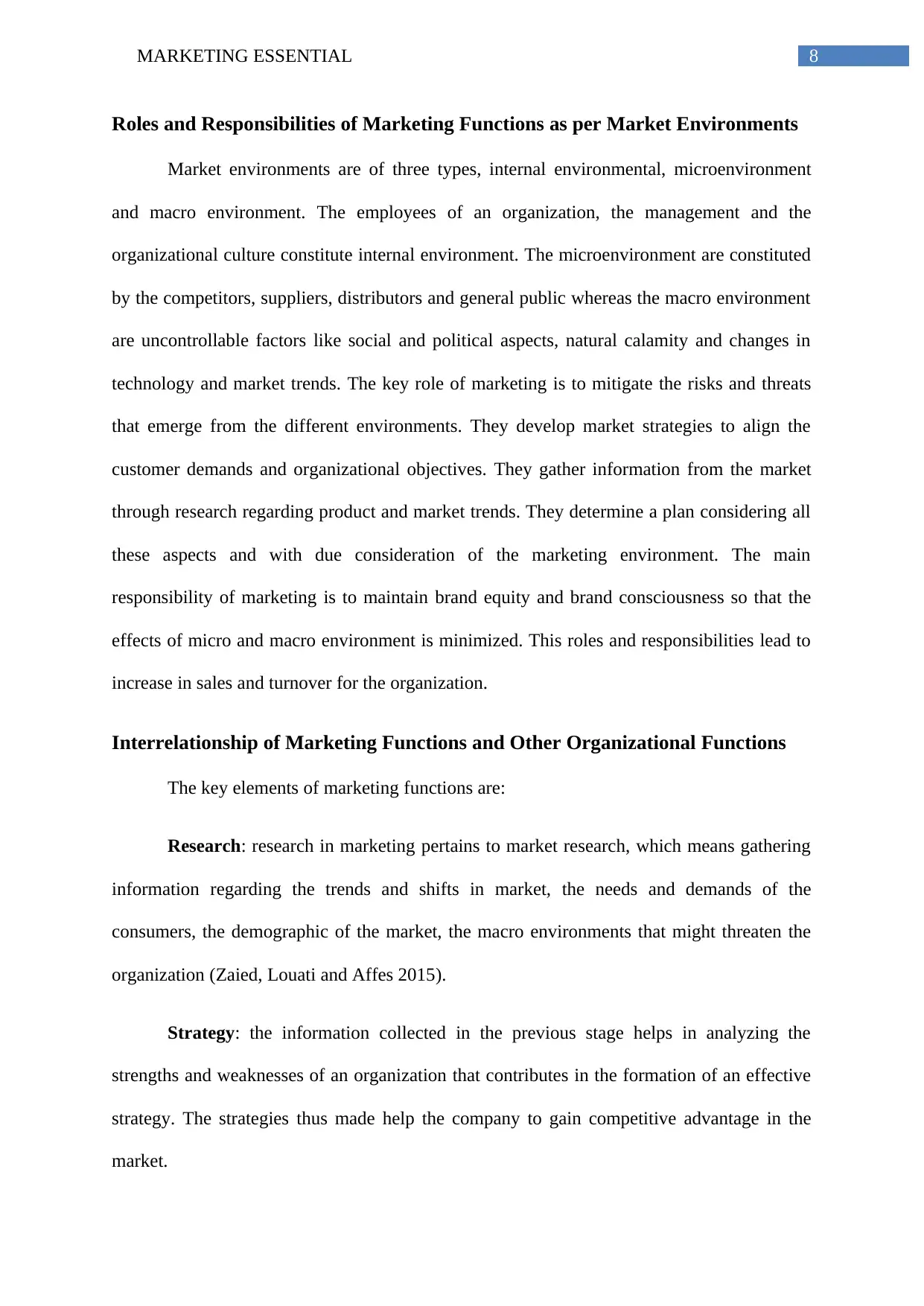
8MARKETING ESSENTIAL
Roles and Responsibilities of Marketing Functions as per Market Environments
Market environments are of three types, internal environmental, microenvironment
and macro environment. The employees of an organization, the management and the
organizational culture constitute internal environment. The microenvironment are constituted
by the competitors, suppliers, distributors and general public whereas the macro environment
are uncontrollable factors like social and political aspects, natural calamity and changes in
technology and market trends. The key role of marketing is to mitigate the risks and threats
that emerge from the different environments. They develop market strategies to align the
customer demands and organizational objectives. They gather information from the market
through research regarding product and market trends. They determine a plan considering all
these aspects and with due consideration of the marketing environment. The main
responsibility of marketing is to maintain brand equity and brand consciousness so that the
effects of micro and macro environment is minimized. This roles and responsibilities lead to
increase in sales and turnover for the organization.
Interrelationship of Marketing Functions and Other Organizational Functions
The key elements of marketing functions are:
Research: research in marketing pertains to market research, which means gathering
information regarding the trends and shifts in market, the needs and demands of the
consumers, the demographic of the market, the macro environments that might threaten the
organization (Zaied, Louati and Affes 2015).
Strategy: the information collected in the previous stage helps in analyzing the
strengths and weaknesses of an organization that contributes in the formation of an effective
strategy. The strategies thus made help the company to gain competitive advantage in the
market.
Roles and Responsibilities of Marketing Functions as per Market Environments
Market environments are of three types, internal environmental, microenvironment
and macro environment. The employees of an organization, the management and the
organizational culture constitute internal environment. The microenvironment are constituted
by the competitors, suppliers, distributors and general public whereas the macro environment
are uncontrollable factors like social and political aspects, natural calamity and changes in
technology and market trends. The key role of marketing is to mitigate the risks and threats
that emerge from the different environments. They develop market strategies to align the
customer demands and organizational objectives. They gather information from the market
through research regarding product and market trends. They determine a plan considering all
these aspects and with due consideration of the marketing environment. The main
responsibility of marketing is to maintain brand equity and brand consciousness so that the
effects of micro and macro environment is minimized. This roles and responsibilities lead to
increase in sales and turnover for the organization.
Interrelationship of Marketing Functions and Other Organizational Functions
The key elements of marketing functions are:
Research: research in marketing pertains to market research, which means gathering
information regarding the trends and shifts in market, the needs and demands of the
consumers, the demographic of the market, the macro environments that might threaten the
organization (Zaied, Louati and Affes 2015).
Strategy: the information collected in the previous stage helps in analyzing the
strengths and weaknesses of an organization that contributes in the formation of an effective
strategy. The strategies thus made help the company to gain competitive advantage in the
market.
⊘ This is a preview!⊘
Do you want full access?
Subscribe today to unlock all pages.

Trusted by 1+ million students worldwide
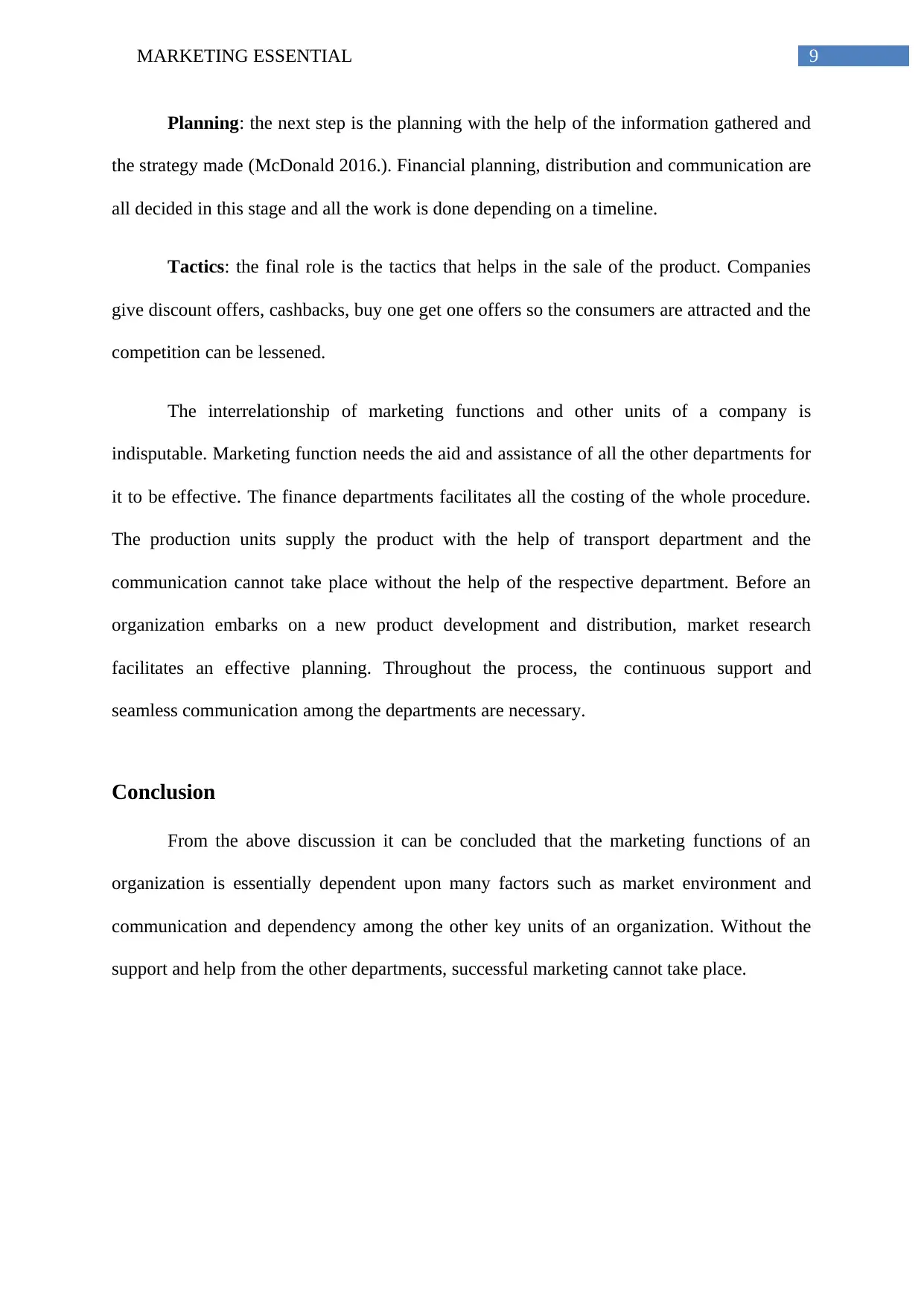
9MARKETING ESSENTIAL
Planning: the next step is the planning with the help of the information gathered and
the strategy made (McDonald 2016.). Financial planning, distribution and communication are
all decided in this stage and all the work is done depending on a timeline.
Tactics: the final role is the tactics that helps in the sale of the product. Companies
give discount offers, cashbacks, buy one get one offers so the consumers are attracted and the
competition can be lessened.
The interrelationship of marketing functions and other units of a company is
indisputable. Marketing function needs the aid and assistance of all the other departments for
it to be effective. The finance departments facilitates all the costing of the whole procedure.
The production units supply the product with the help of transport department and the
communication cannot take place without the help of the respective department. Before an
organization embarks on a new product development and distribution, market research
facilitates an effective planning. Throughout the process, the continuous support and
seamless communication among the departments are necessary.
Conclusion
From the above discussion it can be concluded that the marketing functions of an
organization is essentially dependent upon many factors such as market environment and
communication and dependency among the other key units of an organization. Without the
support and help from the other departments, successful marketing cannot take place.
Planning: the next step is the planning with the help of the information gathered and
the strategy made (McDonald 2016.). Financial planning, distribution and communication are
all decided in this stage and all the work is done depending on a timeline.
Tactics: the final role is the tactics that helps in the sale of the product. Companies
give discount offers, cashbacks, buy one get one offers so the consumers are attracted and the
competition can be lessened.
The interrelationship of marketing functions and other units of a company is
indisputable. Marketing function needs the aid and assistance of all the other departments for
it to be effective. The finance departments facilitates all the costing of the whole procedure.
The production units supply the product with the help of transport department and the
communication cannot take place without the help of the respective department. Before an
organization embarks on a new product development and distribution, market research
facilitates an effective planning. Throughout the process, the continuous support and
seamless communication among the departments are necessary.
Conclusion
From the above discussion it can be concluded that the marketing functions of an
organization is essentially dependent upon many factors such as market environment and
communication and dependency among the other key units of an organization. Without the
support and help from the other departments, successful marketing cannot take place.
Paraphrase This Document
Need a fresh take? Get an instant paraphrase of this document with our AI Paraphraser
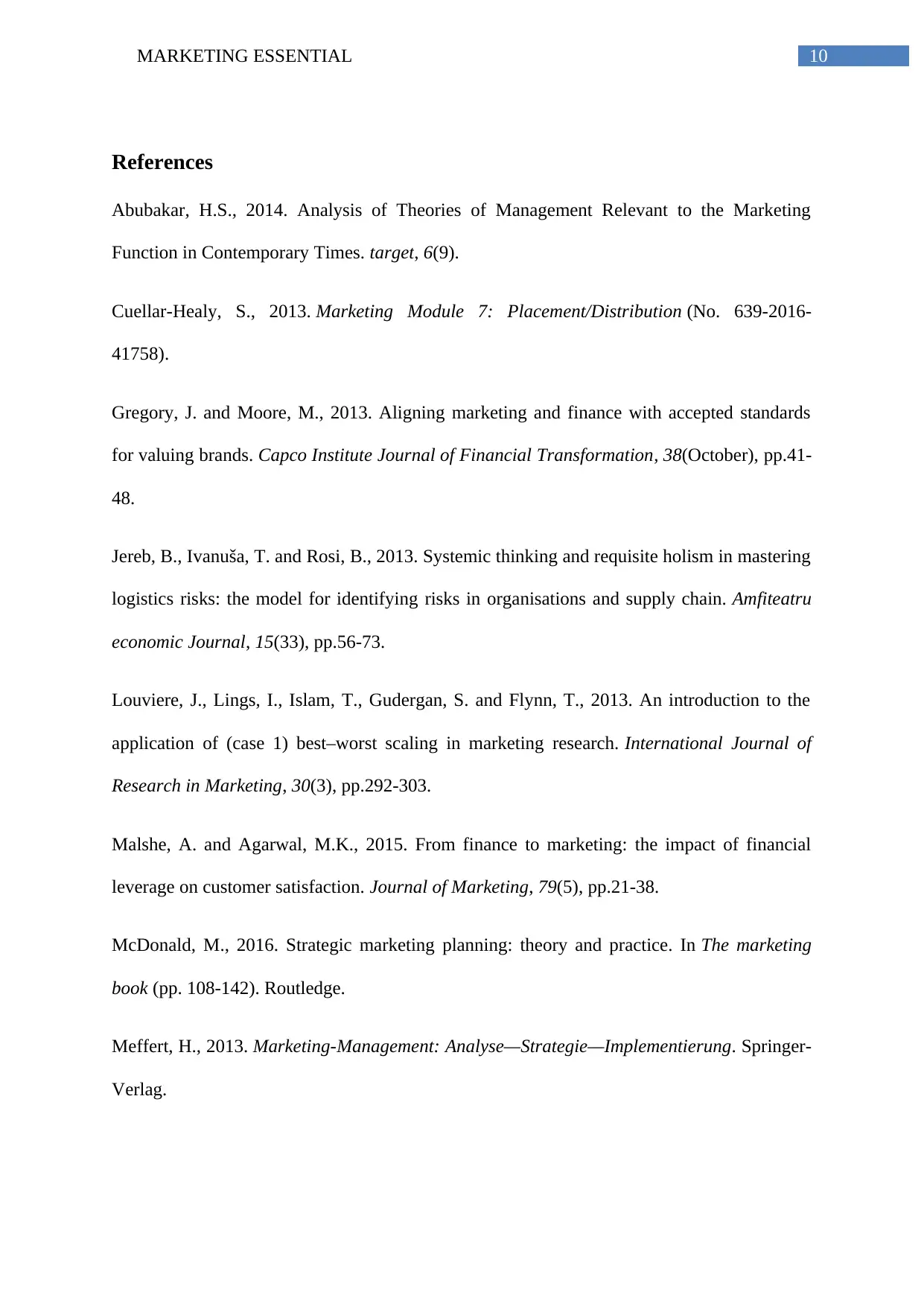
10MARKETING ESSENTIAL
References
Abubakar, H.S., 2014. Analysis of Theories of Management Relevant to the Marketing
Function in Contemporary Times. target, 6(9).
Cuellar-Healy, S., 2013. Marketing Module 7: Placement/Distribution (No. 639-2016-
41758).
Gregory, J. and Moore, M., 2013. Aligning marketing and finance with accepted standards
for valuing brands. Capco Institute Journal of Financial Transformation, 38(October), pp.41-
48.
Jereb, B., Ivanuša, T. and Rosi, B., 2013. Systemic thinking and requisite holism in mastering
logistics risks: the model for identifying risks in organisations and supply chain. Amfiteatru
economic Journal, 15(33), pp.56-73.
Louviere, J., Lings, I., Islam, T., Gudergan, S. and Flynn, T., 2013. An introduction to the
application of (case 1) best–worst scaling in marketing research. International Journal of
Research in Marketing, 30(3), pp.292-303.
Malshe, A. and Agarwal, M.K., 2015. From finance to marketing: the impact of financial
leverage on customer satisfaction. Journal of Marketing, 79(5), pp.21-38.
McDonald, M., 2016. Strategic marketing planning: theory and practice. In The marketing
book (pp. 108-142). Routledge.
Meffert, H., 2013. Marketing-Management: Analyse—Strategie—Implementierung. Springer-
Verlag.
References
Abubakar, H.S., 2014. Analysis of Theories of Management Relevant to the Marketing
Function in Contemporary Times. target, 6(9).
Cuellar-Healy, S., 2013. Marketing Module 7: Placement/Distribution (No. 639-2016-
41758).
Gregory, J. and Moore, M., 2013. Aligning marketing and finance with accepted standards
for valuing brands. Capco Institute Journal of Financial Transformation, 38(October), pp.41-
48.
Jereb, B., Ivanuša, T. and Rosi, B., 2013. Systemic thinking and requisite holism in mastering
logistics risks: the model for identifying risks in organisations and supply chain. Amfiteatru
economic Journal, 15(33), pp.56-73.
Louviere, J., Lings, I., Islam, T., Gudergan, S. and Flynn, T., 2013. An introduction to the
application of (case 1) best–worst scaling in marketing research. International Journal of
Research in Marketing, 30(3), pp.292-303.
Malshe, A. and Agarwal, M.K., 2015. From finance to marketing: the impact of financial
leverage on customer satisfaction. Journal of Marketing, 79(5), pp.21-38.
McDonald, M., 2016. Strategic marketing planning: theory and practice. In The marketing
book (pp. 108-142). Routledge.
Meffert, H., 2013. Marketing-Management: Analyse—Strategie—Implementierung. Springer-
Verlag.
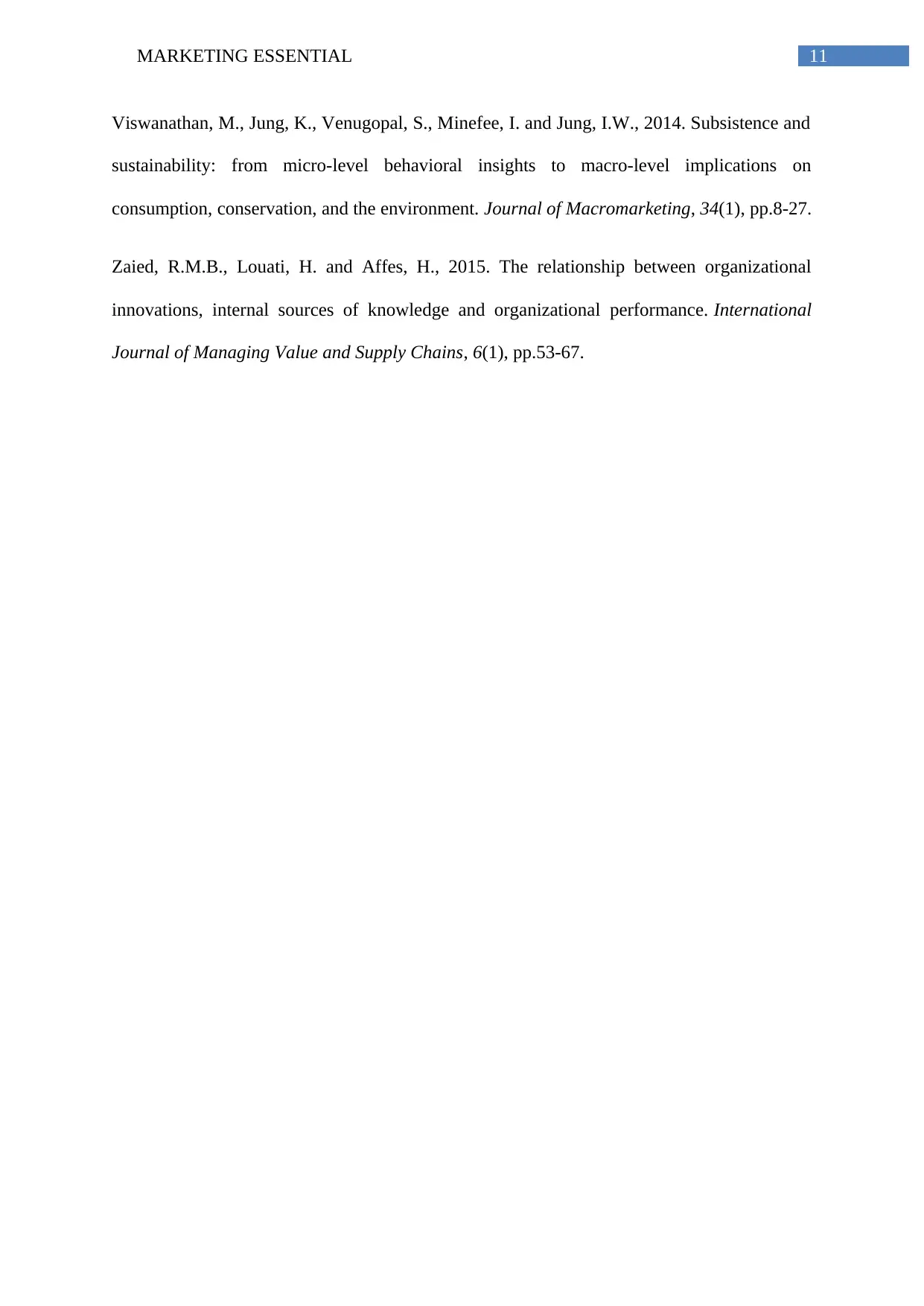
11MARKETING ESSENTIAL
Viswanathan, M., Jung, K., Venugopal, S., Minefee, I. and Jung, I.W., 2014. Subsistence and
sustainability: from micro-level behavioral insights to macro-level implications on
consumption, conservation, and the environment. Journal of Macromarketing, 34(1), pp.8-27.
Zaied, R.M.B., Louati, H. and Affes, H., 2015. The relationship between organizational
innovations, internal sources of knowledge and organizational performance. International
Journal of Managing Value and Supply Chains, 6(1), pp.53-67.
Viswanathan, M., Jung, K., Venugopal, S., Minefee, I. and Jung, I.W., 2014. Subsistence and
sustainability: from micro-level behavioral insights to macro-level implications on
consumption, conservation, and the environment. Journal of Macromarketing, 34(1), pp.8-27.
Zaied, R.M.B., Louati, H. and Affes, H., 2015. The relationship between organizational
innovations, internal sources of knowledge and organizational performance. International
Journal of Managing Value and Supply Chains, 6(1), pp.53-67.
⊘ This is a preview!⊘
Do you want full access?
Subscribe today to unlock all pages.

Trusted by 1+ million students worldwide
1 out of 40
Related Documents
Your All-in-One AI-Powered Toolkit for Academic Success.
+13062052269
info@desklib.com
Available 24*7 on WhatsApp / Email
![[object Object]](/_next/static/media/star-bottom.7253800d.svg)
Unlock your academic potential
Copyright © 2020–2025 A2Z Services. All Rights Reserved. Developed and managed by ZUCOL.



